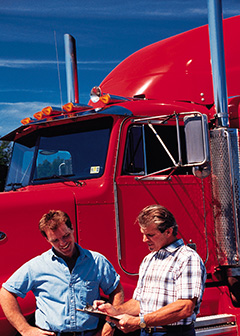How to Become a Heavy or Tractor-trailer Truck Driver About this section

Drivers learn the federal laws and regulations governing interstate trucking.
Heavy and tractor-trailer truck drivers usually have a high school diploma and attend a professional truck driving school. They must have a commercial driver’s license (CDL).
Education
Most companies require their truck drivers to have a high school diploma or equivalent.
Many prospective drivers attend professional truck driving schools, where they take training courses to learn how to maneuver large vehicles on highways or through crowded streets. During these classes, drivers also learn the federal laws and regulations governing interstate truck driving. Students may attend either a private truck-driving school or a program at a community college that lasts between 3 and 6 months.
Upon finishing their classes, drivers receive a certificate of completion.
Licenses, Certifications, and Registrations
All long-haul truck drivers must have a commercial driver’s license (CDL). Qualifications for obtaining a CDL vary by state but generally include passing both a knowledge test and a driving test. States have the right to refuse to issue a CDL to anyone who has had a CDL suspended by another state.
Drivers can get endorsements to their CDL that show their ability to drive a specialized type of vehicle. Truck drivers transporting hazardous materials (HAZMAT) must have a hazardous materials endorsement (H). Getting this endorsement requires passing an additional knowledge test and a background check.
Federal regulations require CDL drivers to maintain a clean driving record and pass a physical exam every two years. They are also subject to random testing for drug or alcohol abuse. Truck drivers can have their CDL suspended if they are convicted of driving under the influence of alcohol or drugs or are convicted of a felony involving the use of a motor vehicle.
Other actions can result in a suspension after multiple violations. The Federal Motor Carrier Safety Administration website has a list of these violations. Additionally, some companies have stricter standards than what federal regulations require.
Training
After completing truck-driving school and being hired by a company, drivers normally receive several weeks of on-the-job training. During this time, they drive a truck accompanied by an experienced mentor-driver in the passenger seat. This period of on-the-job training is given so that the new drivers will learn more about the specific type of truck they will drive and material they will transport.
Important Qualities
The following are examples of qualities that are important for these workers to perform their duties. For more information, visit the Employment Projections (EP) skills data page.
Hand-eye coordination. Drivers of heavy trucks and tractor-trailers must be able to coordinate their legs, hands, and eyes simultaneously so that they will react appropriately to the situation around them and drive the vehicle safely.
Hearing ability. Truck drivers need good hearing. Federal regulations require that a driver be able to hear a forced whisper in one ear at 5 feet away (with or without the use of a hearing aid).
Physical health. Federal regulations do not allow people to become truck drivers if they have a medical condition, such as high blood pressure or epilepsy, which may interfere with their ability to operate a truck. The Federal Motor Carrier Safety Administration website has a full list of medical conditions that disqualify someone from driving a long-haul truck.
Visual ability. Truck drivers must be able to pass vision tests. Federal regulations require a driver to have at least 20/40 vision with a 70-degree field of vision in each eye and the ability to distinguish the colors on a traffic light.
 United States Department of Labor
United States Department of Labor








